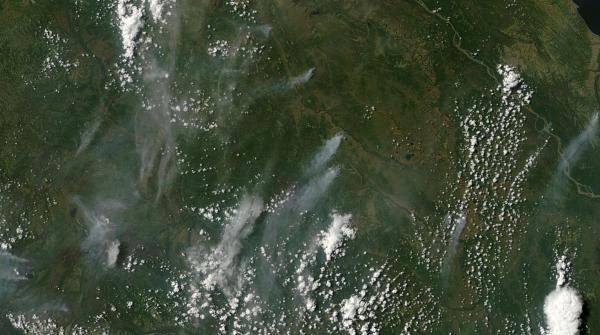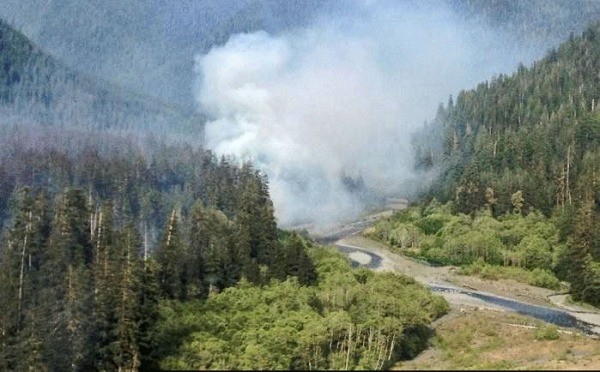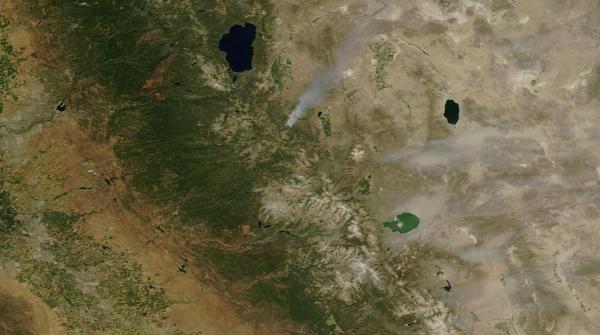“Worst Fire Conditions On Record” — As Heatwaves, Drought Bake North American West, Wildfires Erupt From California to Alaska
22
June, 2015
There
are 146 wildfires burning in Alaska today.
A total that is likely to see at least another dozen blazes added to
it by midnight. A total that has already absorbed the entire
firefighting capacity of the State and has drawn hundreds of
firefighters from
across the country in places as far away as Pennsylvania.
(MODIS
satellite shot of wildfires erupting over a sweltering Southwestern
Alaska on Sunday, June 21. Wildfires in permafrost regions of the
Arctic like Alaska are particularly concerning as they are one
mechanism that returns ancient sequestered carbon to the Earth
atmosphere. A sign of a feedback set off by human warming that will
worsen with continued fossil fuel emissions. Image
source: LANCE-MODIS.)
Deadhorse,
at the center of North Slope oil fields above the Arctic Circle set
an all time record high of 82 degrees (Fahrenheit) on Sunday. That’s
3 degrees hotter than the previous all time record high of 79 degrees
set on August 16, 2004. The hottest reading for June at that location
was a 68 degree measure set in 2007. So, basically, Deadhorse just
shattered the all-time record for June by 14 degrees (F) and the
globally record hot summer of 2015 has only now gotten started.
Other
locations experiencing new records for just Sunday included Kotzebue,
which set a new all time record highest low temperature of 62 degrees
(F). This reading broke the previous all time high minimum mark of 56
degrees, set in 1987. Bethel and Yakutat both tied their daily high
minimum temperature records at 54 and 52 degrees, respectively.
And
yesterday was just one day in long period of record heat for the
State. Last
month’s NOAA analysis showed
temperatures fully 7 degrees Fahrenheit above average. It’s a
record heating that is now setting off severe wildfires all over
Alaska. According to the state’s Wildland
Fire Information Center,
the relentless heat and dryness has turned spruce, hardwoods, brush,
and tundra into dry fuels vulnerable to any ignition source. Over the
past week, ignition has come in the form of lightning — with most
of Alaska’s 2015 wildfires set off by nature’s spark.
As
a result we are seeing nearly double the number of fires during June
compared to a typical year. Fires that have already destroyed 30
structures, forced evacuations, and tapped Alaska’s firefighting
resources to its limits.
Wildfires
Burning in the Rainforests of Washington as Major Heatwave Approaches
Record
hot temperatures and wildfires, unfortunately, are not just an issue
for Alaska. They’re a prevalent concern all up and down Western
North America. A zone that has seen several years of record hot
temperatures and dryness. Extreme weather events fueled by such
global warming-linked phenomena as a Ridiculously Resilient high
pressure Ridge over the Northeast Pacific that has kept heatwave and
drought conditions firmly entrenched throughout much of the region
for months and years. An atmospheric condition that is also linked to
a hot ocean surface water ‘Blob’ in the Northeast Pacific (which
is itself implicated in a growing number of marine species deaths).
(Paradise
Fire burning near a drought-shrunken creek in the rainforests of
Olympia National Park, Washington. Image source: NPS and Wildfire
Today.)
This
week, the added heat also generated wildfires in unusual areas like
the rainforests of Washington State’s Olympic Peninsula. Driest
conditions since 1951 have resulted in a great deal of fire
resiliency loss for forests in the region (1951 was the year of the
historic Five Forks Fire, one of the worst ever to impact Washington
State). Already,
a rare early summer wildfire (called the Paradise Fire) has burned
through 417 acres of forest.
Firefighters
are doing their best to contain the blaze. But the record heat and
dryness are multiplying fuel sources. Fires are enabled by dried
lichens growing high up in the trees. When flames touch the lichens
they rapidly ignite sending sparks to other lichen-covered tree tops.
In this way, flames can leap rapidly from tree to tree under current
conditions.
It’s
very unusual to see fires in this rainforest zone. And when ignitions
have occurred in those very rare cases, they have typically flared
during late Summer and early Fall. So this June burning has fire
officials very concerned — especially given the nearly
unprecedented fire hazard conditions throughout the State. Conditions
that are predicted to rapidly worsen as an extreme heatwave is
expected to build through the coming weekend.
(A
major heatwave is predicted to invade the US West and Northwest
States this weekend. Washington and Oregon are predicted to
experience temperatures more typical of desert sections of California
and Arizona. Image source: Climate
Reanalyzer.)
Temperatures
over large stretches of Washington and Oregon are expected to climb
into the 90s and 100s, possibly reaching the 110s (Fahrenheit) by
Sunday. For these typically cool, wet States, this brutal heat blow,
should it emerge as predicted, will set off a spate of all time
record high temperature readings, deepen drought conditions extending
northward from California, and heighten fire conditions that are
already in the range of worst ever experienced for sections of these
States.
California
Experiencing “Worst Fire Conditions On Record”
Moving
further south along the U.S. West Coast we come at last to the
drought hot zone that is California. A State that is now enduring its
fourth year of drought. A drought that tree ring studies show is
likely the worst such event in 1,000 years.
These
harsh climate conditions were starkly highlighted this weekend
as reports
from State emergency planning officials now indicate that California
is currently experiencing its worst fire conditions on record.
Ken
Pimlott, Director of CAL FIRE noted:
We measure the fuel moisture content of all of the vegetation -the brush and the trees and we track that over the course of time and compare it month to month each year. And we put it through formulas and determine how much energy and how much heat it will put out when it’s burning. And we have seen -we saw it last year and we will see it again this year- we’ll be reaching records for potential heat output for times of the year that would normally not be burning in those conditions.
(Large
wildfire burns in forests along the slopes of Sierra Nevada Mountains
whose peaks are now almost entirely devoid of snow cover. Note that
remaining glaciers are shown turning a dull brown in the June
21 MODIS satellite shot.)
So
far this year over 1,100 wildfires have already ignited throughout
the State. That’s nearly twice the typical number of 650 blazes
popping up by this time of year. Exacerbating this stark context is a
state water resource crisis compounded by dwindling Sierra Nevada
snowpacks and dead
trees that now number in the millions.
This
is not Normal, Nor Should We View Widespread, Related Events in
Isolation
Record
and unusual Alaska, Washington, and California wildfires this season
are, thus, not occurring in isolation, but as an inseparable feature
of ongoing climate trends related to human-caused global warming. In
this case, heatwaves are related to visible and extreme record ocean
and atmospheric temperatures that have been ramping both globally and
in the regions affected over past years and decades. And the fact
that 2015 is continuing as the hottest year on record globally should
also not be viewed as separate from the events witnessed all up and
down the North American West Coast. Events that were largely
predicted in many global climate models assessing the impacts of
human based greenhouse gas warming on this vital national and global
region.
We’ll
end here by considering this thought — it’s only June, yet up and
down the North American West Coast we are experiencing some of the
worst heat, drought, and fire conditions ever recorded. It’s only
June…
Links:
Hat
Tip to DT Lange
Hat
Tip to Andy in San Diego







No comments:
Post a Comment
Note: only a member of this blog may post a comment.